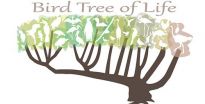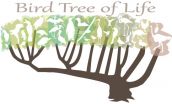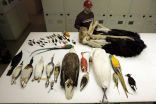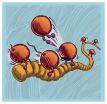(Press-News.org) CHAMPAIGN, Ill. -- An international effort involving more than 100 researchers, nine supercomputers and about 400 years of CPU time has yielded the most reliable avian tree of life yet produced, researchers report in the journal Science. The tree reflects the evolutionary relationships of 48 species of birds.
The paper describing the bird family tree is one of eight articles on avian evolution published together in Science. The overall endeavor was coordinated by Erich Jarvis of Duke University; M. Thomas P. Gilbert of the Natural History Museum of Denmark; and Guojie Zhang of the Beijing Genomics Institute at Shenzhen.
The computational effort, led by University of Illinois Founder Professor of Bioengineering and Computer Science Tandy Warnow and University of Texas at Austin graduate student Siavash Mirarab, took more than four years to complete.
"Different parts of the genome can actually have different histories, and this data set had this in abundance," Warnow said. "We observed significant conflict across the genome, which required the development of new statistical methods in order to develop a robust tree."
"Figuring out the evolution of birds is really hard," Mirarab said. "Most of the birds we know today, about 95 percent, belong to the group Neoaves. These birds appeared, it seems, in a period of a few million years. When a lot of new species appear in a short period of time, it makes reconstructing their relationships much harder."
Many scientists believe this "big bang" of bird evolution occurred about 65 million years ago, just after the Cretaceous-Paleogene extinction, which killed off the "other dinosaurs," Mirarab said. (Most scientists agree today's birds are the descendants of a few "avian dinosaurs.")
The exact timing of major events in bird evolution is still being nailed down, however, said Edward Braun, a biology professor at the University of Florida and a co-author on the paper.
"Our results suggest that modern birds diversified in the wake of the mass extinction that marked the end of the age of dinosaurs, but we cannot exclude the possibility that birds began diversifying before the extinction," Braun said.
The new study offers evidence, however, that birds diverged more recently than earlier studies had indicated, Warnow said. This finding is more consistent with the fossil record, she said.
The new analysis helps clarify the evolutionary relationships of major groups of birds, showing which groups share more recent ancestors and which are more distantly related to each other.
A key, unexpected finding involves an early event in the evolution of the Neoaves (knee-oh-AY-veez), a group that includes songbirds, raptors, parrots, herons, doves, penguins and most other birds.
"We found in this study something that was different from anything suggested before - a divergence between two groups of Neoaves, groups we call Columbea and Passerea," Mirarab said. "And what's really interesting about this divergence is that the group Columbea includes birds that you would not think were related, like flamingoes and pigeons. This means that flamingoes are more closely related to pigeons than they are to pelicans, for example."
Another interesting finding is that some birds of prey are not as closely related to each other as they are to other species that have very different traits.
"If you look at them, you would think that falcons are more eagle-like than they are parrot-like," Mirarab said. "But falcons are more closely related to parrots and passerines (a group that includes songbirds) than they are to eagles or vultures."
Of the birds whose genomes were analyzed, only five were not Neoaves. Chickens, turkeys and ducks inhabit a separate branch of the avian tree. Ostriches and tinamous stem from the most ancient branch on the tree. (See interactive infographic.)
The study adds support to the hypothesis that some traits - such as vocal learning or foot-propelled underwater diving - evolved independently among different groups of birds. There also is substantial evidence that the core landbirds - a group that includes songbirds, parrots, falcons, owls, woodpeckers and eagles - share a common ancestor that was an apex predator, at the top of the food chain.
To get these results, the computational team analyzed 14,000 different regions within the genomes of the 48 bird species, looking at both coding and non-coding sites in the genes.
"This was an incredible amount of effort from a huge number of people," Warnow said. "It took 400 CPU years across supercomputing centers all over the world. This was only achievable because of the expertise of the researchers and the supercomputer centers, and having that much time on them."
INFORMATION:
The National Science Foundation, the Howard Hughes Medical Institute and the Guggenheim Foundation funded Warnow and Mirarab.
Editor's notes:
To reach Tandy Warnow, call 217-300-3087; email warnow@illinois.edu.
To reach Siavash Mirarab, email smirarab@cs.utexas.edu.
The paper, "Whole genome analyses resolve early branches in the tree of life of modern birds," is available to members of the media from the journal Science
Crocodiles are the closest living relatives of the birds, sharing a common ancestor that lived around 240 million years ago and also gave rise to the dinosaurs. A new study of crocodilian genomes led by scientists at UC Santa Cruz reveals an exceptionally slow rate of genome evolution in the crocodilians (a group that includes crocodiles, caimans, alligators, and gharials).
The UC Santa Cruz team used the crocodilian genomes, combined with newly published bird genomes, to reconstruct a partial genome of the common ancestor of crocodiles, birds, and dinosaurs. The study, ...
Conventional wisdom holds that changing the views of voters on divisive issues is difficult if not impossible -- and that when change does occur, it is almost always temporary.
But Michael LaCour, a UCLA doctoral candidate in political science, and Donald Green, a Columbia University political science professor, have demonstrated that a single conversation can go a long way toward building lasting support for a controversial social issue. In addition -- nearly as surprisingly -- the effect tends to spill over to friends and family members.
The key is putting voters ...
A new computational technique developed at The University of Texas at Austin has enabled an international consortium to produce an avian tree of life that points to the origins of various bird species. A graduate student at the university is a leading author on papers describing the new technique and sharing the consortium's findings about bird evolution in the journal Science.
The results of the four-year effort -- which relied in part on supercomputers at the university's Texas Advanced Computing Center (TACC) -- shed light on the timing of a "big bang" in bird evolution, ...
RIVERSIDE, Calif. - The absence of teeth or "edentulism" has evolved on multiple occasions within vertebrates including birds, turtles, and a few groups of mammals such as anteaters, baleen whales and pangolins. Where early birds are concerned, the fossil record is fragmentary. A question that has intrigued biologists is: Based on this fossil record, were teeth lost in the common ancestor of all living birds or convergently in two or more independent lineages of birds?
A research team led by biologists at the University of California, Riverside and Montclair State University, ...
LOS ANGELES, Dec. 11, 2014-- It's possible to lastingly persuade conservative voters to support a controversial issue like marriage for same-sex couples--and at a greatly accelerated rate compared to their neighbors--according to groundbreaking data published in this week's issue of the peer-reviewed journal Science. The 12-month study also shows how the Los Angeles LGBT Center's voter persuasion methods reduced anti-gay prejudice and may have the potential to reduce other forms of prejudice.
The independent researchers who led the study, prominent Columbia University ...
This news release is available in Danish and also Chinese on EurekAlert! Chinese.
An international effort to sequence the genomes of 45 avian species has yielded the most reliable tree of life for birds to date. This new avian family tree helps to clarify how modern birds--the most species-rich class of four-limbed vertebrates on the planet--emerged rapidly from a mass extinction event that wiped out all of the dinosaurs approximately 66 million years ago.
It reveals how some of the earliest bird species diverged, answering many long-standing questions about the common ...
SALT LAKE CITY, Dec. 11, 2014 - University of Utah researchers ran biochemical analysis and computer simulations of a livestock virus to discover a likely and exotic mechanism to explain the replication of related viruses such as Ebola, measles and rabies. The mechanism may be a possible target for new treatments within a decade.
"This is fundamental science. It creates new targets for potential antiviral drugs in the next five to 10 years, but unfortunately would not have an impact on the current Ebola epidemic" in West Africa, says Saveez Saffarian, senior author of ...
(SALT LAKE CITY) - Examination of DNA from 21 primate species - from squirrel monkeys to humans - exposes an evolutionary war against infectious bacteria over iron that circulates in the host's bloodstream. Supported by experimental evidence, these findings, published in Science on Dec. 12, demonstrate the vital importance of an increasingly appreciated defensive strategy called nutritional immunity.
"We've known about nutritional immunity for 40 years," says Matthew Barber, Ph.D., first author and postdoctoral fellow in human genetics at the University of Utah. "What ...
How birds evolved to have characteristics including feathers, flight and song is revealed with new clarity in a major study of their family tree.
The international study charts a burst of evolution that took place after the mass extinction of dinosaurs, 66 million years ago. This step-change gave rise to nearly all of the species of birds that we see on the planet today - more than 10,000 varieties.
The four-year project - which included researchers from the University of Edinburgh's Roslin Institute - decoded and compared the entire genetic fingerprint of 48 bird species. ...
Two penguin genomes have been sequenced and analyzed for the first time in the open access, open data journal GigaScience. Timely for the holiday season, the study reveals insights into how these birds have been able to adapt to the cold and hostile Antarctic environment.
Antarctic penguins are subject to extremely low temperatures, high winds, and profound changes in daylight. They have developed complicated biological systems to regulate temperature and store energy for long-term fasting. Most studies have focused on the physiological and behavioral aspects of their ...





